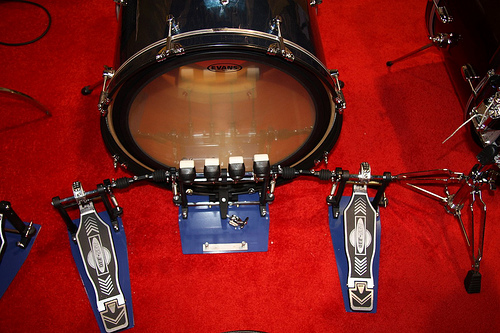The main thing that will make a difference in how the beater sounds is what material it’s made out of. Softer materials like felt or wool will have a more rounded sound than hard materials, like rubber and wood. Which one is right for you will depend on the genre of music that you play and your own personal playing technique. If you’re looking for a new bass drum beater, check out the 4 options listed below, which are some of the best bass drum beaters on the market today.
Pearl B200QB
If you play in a lot of different styles and genres, the extra versatility you’ll get from this four-sided Pearl beater is probably pretty exciting. Each of the different faces will produce its own distinctive tone. It has two plastic faces and two felt faces, letting you choose how hard you want your sound to be, and there are two different orientations for each surface material, giving you more control over how it strikes your drum head.
Pearl is a brand trusted by drummers around the world for their high-quality equipment, and this beater (see full specs) is no different. It’s durable, well-balanced, and has a consistent feel and response across the four head surfaces.
Vater Vintage Bomber
If you play a lot of jazz or blues, give a listen to the Vater Vintage Bomber. It was designed to emulate the lamb’s wool beaters that were popular with jazz drummers in the ‘50s and ‘60s, using a cork core surrounded by soft synthetic wool that is more durable and consistent than the beaters of old while still maintaining the vintage look and feel.
The end result (see full specs) is a tone that’s got an incredible low end response, with a mid- and high-end tone that’s softer than what you get from more modern felt beaters. The overall effect is powerful, boomy, and well-rounded—exactly the tone you’re looking for in a jazz kit. Clearly, this is one of the best bass drum beaters period.
Tama TAMCB90F Felt Cobra Beater
If you’re a rock drummer looking for a more modern sound, the Iron Cobra beater from Tama is definitely worth a look. It’s designed to be light-weight, giving you a faster, smoother response and that ultimately means more control and power with less effort. This makes it great for even double-bass work, giving you a punchy and clear attack at any tempo.
Another great feature of the Iron Cobra is the fact that you can adjust the angle of impact, changing the way the beater strikes the head. They’ve also improved the durability over their previous beater models, doubling their lifespan and making them perfect for especially heavy players.
Gibraltar SC-DSAB
For a great beater that doesn’t cost much, the Gibraltar self-aligning beater is your top contender. Like the Pearl beater above, it gives you two different surface options—a curved felt surface for a deeper tone, and a flat plastic surface for a punchier attack.
It’s on the heavier side compared to other beaters on this list, meaning it might not be the best option if you have to do a lot of quick bass drum work, but for most players and styles it offers a lot of versatility and power for an impressive value. In my book, this is the best bass drum beater for the money.
Materials
The main difference you’ll find between different beaters is in the material used to make them. While you’ll also of course find different sizes of beater, and the mass of the beater will have an influence over the final tone, you’ll hear the difference much more easily between a felt and a rubber beater, for example, than between different widths of wood beaters. Which material you’re looking for is the first decision you have to make when you’re shopping for a new beater.
There are four main materials used in bass drum beaters. From hardest to softest, they are rubber, wood, felt, and wool:
- Rubber beaters have the least sustain and most power, though for many people they don’t give you a very tuneful or complex bass drum sound.
- A lot of players love wood beaters because they have a natural sound that’s more similar to the sound of your drumsticks hitting your other drum heads, but some people find them overly bright or sharp.
- Felt beaters are more common and have a more versatile sound. They give you a rounded, thumping tone suitable for a wide range of music, from soft folk to hard rock.
- Finally, wool beaters are the softest, and are the best suited for quieter styles, like jazz, since they won’t give you the power and articulation of harder materials.
Certain beater materials will also be more durable than others. Rubber and wood beaters are likely to take more of a beating before failing than felt beaters, and you’ll generally find that wool beaters have the shortest lifespans. Exactly how long your beater last will depend on how hard and how often you play.
Often, the best bass drum beaters give you a choice of different materials. This can be an excellent way to go if you’re a relative beginner, letting you hear the difference between different material types and pick the one that’s best suited to your sound.
Keep in mind that the design of the pedal mechanism itself and the drum placement will also have an impact on how the beater strikes the drum head, and how it ultimately sound. Beaters that are self-adjusting will help you make sure you’re using the right placement, but you shouldn’t assume it will always get things exactly right, and don’t be afraid to make adjustments if you’re not quite happy with the sound you’re getting.








